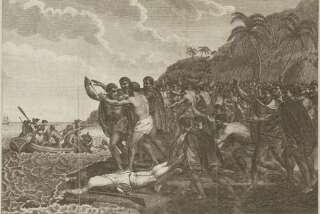The path to a new empire
On Jan. 6, 1492, the victorious armies of Spain’s Catholic monarchs, Ferdinand and Isabel, entered the Muslim city of Granada. The city, with its exquisite gardens and terraced palaces, had been the last bastion of the once-great Islamic civilization of Al-Andalus, which at its height had reached all the way from the Mediterranean to the Pyrenees. Now it was no more. Among the crowds of onlookers that day was a middle-aged Genoese navigator with graying red hair. His name was Christopher Columbus, and he had come to peddle to the Catholic majesties a seemingly absurd project.
Columbus had persuaded himself, by reading a highly eclectic collection of books, that the world was “very much smaller than is commonly supposed.” On his reckoning, what lay between Europe and Asia was not, as was believed, a massive “Ocean Sea,” which included both the Atlantic and the Pacific oceans, with nothing in it except a handful of mythical islands (of which the names of two, Brazil and California, later made their way to the American mainland) but, instead, a single strip of water roughly the size of the Atlantic. He therefore proposed to sail westward from Spain until he reached the shores of what was then known as “Cathay,” a vague geographical area that described most of Southeast Asia from Malaysia to the Central Asian steppe.
By so doing, he would establish a permanent sea route to the fabled wealth of the Orient, thereby enriching himself and his patrons. The experts, quite rightly, scoffed at this; but Isabel, after much persuasion, decided to give Columbus a chance. Spain was in fierce competition with Portugal, which had already staked out territory in Africa, and the opportunity seemed too good to miss. She did not give Columbus very much: two small ships, the Nina and the Pinta, barely more than fishing boats, and a somewhat larger vessel, the Santa Maria.
Columbus set sail, writes Hugh Thomas in “Rivers of Gold,” “half an hour before sunrise” on Aug. 3, from the port of Palos de la Frontera in southern Spain. Most people confidently expected never to see him again. On Oct. 12, he made landfall on an unidentified island that, as he recorded in his journal, “the natives call Guanahani” and he promptly renamed “San Salvador” -- Holy Savior. Columbus had thus, as later generations would have it, “discovered America.”
Although it soon became clear that whatever Columbus had stumbled across, it was hitherto unknown to European geography, Columbus remained convinced to his dying day that he had landed on the outer fringes of the lands of the “Great Khan.” There were good reasons for his insistence, apart from his refusal to look at the evidence. No one in the late 15th century wanted a “New World,” unless of course it had an abundance of the goods most Europeans were after -- above all, precious metals and spices, which the islands Columbus had run across clearly did not have. What everyone wanted -- and what, five years later, the Portuguese Vasco da Gama gave them-- was a way of tapping directly into lucrative trade with China and India.
Columbus had not discovered a westward route to Asia. What he had done, inadvertently, was to set in motion the European scramble for America. It is with this, the initial years of what was finally to become the fabled Catholic monarchy, a world empire on which the “sun never set,” borrowing from the Italian poet Ariosto, that Thomas’ “Rivers of Gold” is concerned. It is a familiar enough story in its details. But it has rarely been told before in its entirety or with such flare. Thomas has already written widely and persuasively on the history of the Spanish empire, as well as voluminously on the history of Cuba and the conquest of Mexico.
“Rivers of Gold” has all the virtues of its predecessors: an unflagging narrative, a host of characters and a way of holding the reader’s attention even when recounting the often-wearying details of early-modern diplomatic history. There have been many histories of the Spanish empire written, like this one, for the informed general reader -- the most recent, “Empire” by Henry Kamen, appeared only last year -- but most of them skip over these early years in their haste to reach the more dramatic moments, especially the conquest of the great indigenous civilizations of Mexico and Peru.
“Rivers of Gold” covers the conquest of Mexico, but its main concern is with the establishment of the Spanish overseas empire in the years before it became but one part of the wider imperial politics of the Hapsburg ruler Charles V, whose domains spanned most of Central and Southern Europe and for whom America, “the new golden land,” was never much more than a glitzy sideshow. This is the period of the first tentative voyages by Columbus and a succession of other navigators. The most celebrated of these, the Florentine Amerigo Vespucci, was the first to recognize, as he sailed along the coast of Brazil in 1501-02, that this was indeed an unknown continent (and would be rewarded by having it named after him). Above all, these are the years of the earliest and deadliest “encounters” between the heavily armed and disease-bearing Europeans and the primitive inhabitants of the Americas. It was the first time in their histories that both groups came face to face with people whose ways of life, beliefs, appearance and very existence were beyond their experience. The Indians who drowned a Spaniard to ascertain whether he was mortal were no more credulous, for example, than Panfilo de Narvaez, who sailed off to Florida in search of the fountain of eternal youth.
Thomas traces the complex political maneuverings of these early years in which crown officials, would-be settlers and the missionary orders battled for a share in the spoils -- human, mineral and spiritual. The semi-criminal underclass to which so many of the earlier settlers belonged slaughtered with impunity the indigenous populations of the islands who stood in their way. The stories of these massacres, when they reached Europe, were worked over by hostile Protestant propagandists into what has come to be called the “Black Legend,” an image of inhumanity that would reverberate down the centuries.
These were the years in which the man who was to become known throughout the Americas as the “Defender of the Indians,” Bartolome de las Casas, began his long lifetime’s struggle against what he called “the destruction of the Indies.” In addition to an outpouring of pamphlets denouncing the behavior of the colonists, in 1520 Las Casas made the first of two doomed attempts to build a new kind of colony -- Thomas calls it “utopian” -- in Cumana on the Venezuelan coast. There he created a community of Indians, priests and “simple laborers and honest farmers” brought from Castile who, he hoped, would live in industrious and pious harmony with one another. (The priests and the “simple laborers and honest farmers” were massacred, after a slaving raid on the area, by Guayqueri Indians who could not be expected to distinguish between one Spaniard and the next.)
These were only beginnings. But the struggles between the various factions -- crown servants, unscrupulous settlers, the largely well-intentioned missionaries and a handful of outspoken critics of the administration, such as Las Casas -- were to establish a pattern that, in the years that followed, would determine the legal and, in some broader sense, cultural identity of the Spanish monarchy until the early 19th century.
“Rivers of Gold” ends with the first circumnavigation of the world under the command of Fernao de Magalhaes, known to the English as Magellan. Like Columbus, Magellan had gone in search of a westward passage, this time to the Spice Islands, an archipelago in the Pacific Ocean where most of the spices and cloves sold in Europe originated. Unlike Columbus, he found it, although only by sailing around Cape Horn and losing most of his ships and, eventually, his own life en route.
When the Victoria, the only one of Magellan’s five ships to complete the journey, reached Spain on Sept. 6, 1522, the cloves she carried in her hold covered the expenses of the entire voyage, the loss of four ships and turned a profit for the expedition’s principal backer. It was a journey that would eventually change the direction of Spanish expansion. Here, “Rivers of Gold” concludes, was proof that ship-born commerce could be immensely profitable. Appropriately, Thomas ends with a brief history of Seville, the city at which the Victoria made its final landfall. It was here that Columbus returned from his first voyage; it was here that Cortes would come, in Thomas’ words, “after conquering the extraordinary monarchy of the Mexica.” And it was from here that most of the expeditions in the intervening 30 years had set sail. In their very different ways, Cortes’ conquest and the voyage of the Victoria marked the beginning of a new kind of empire, one that would reach all the way to China and that “Rivers of Gold” carefully traces from its earliest days. *
More to Read
Sign up for Essential California
The most important California stories and recommendations in your inbox every morning.
You may occasionally receive promotional content from the Los Angeles Times.










